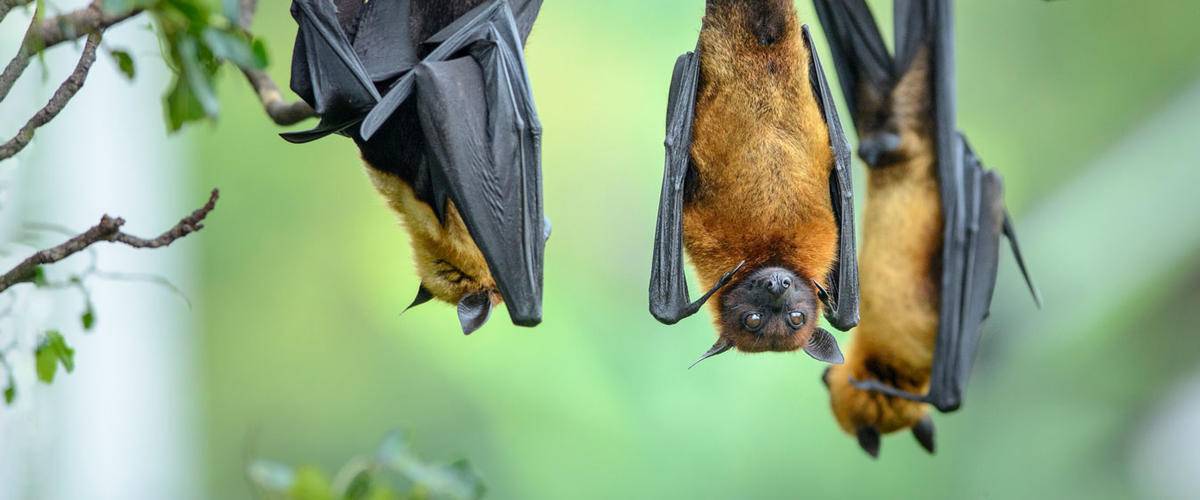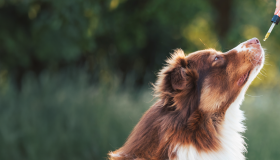
October 13, 2022 – Bats have a reputation as virus spreaders – is that fair? What’s the truth about bats, viruses and the spread of disease. Host Dr. Kelly Diehl asks virus expert Dr. Angela Bosco-Lauth to separate truth from fiction when it comes to bats and their viruses.
Resources:
https://www.morrisanimalfoundation.org/search?search=bat
https://www.morrisanimalfoundation.org/article/episode-48-rabies-update
0:00:09.9 Dr. Kelly Diehl: Welcome to Fresh Scoop episode 49, Going Batty. I'm your host, Dr. Kelly Diehl, Morris Animal Foundation, Senior Director of Science and Communication. And today, we'll talk to Dr. Angela Bosco-Lauth. Dr. Bosco-Lauth is an Assistant Professor at Colorado State University, and she studies infectious disease of humans and animals. Welcome, Angela.
0:00:36.3 Dr. Angela Bosco-Lauth: Thank you so much. It's a pleasure to be here today.
0:00:39.6 DD: Before we get started, I ask everybody this. Can you tell us a bit about yourself, what led you to become a veterinarian and kind dx of get into the... Get to your PhD and study infectious diseases?
0:00:52.1 DB: Yeah, absolutely. I think probably like many of your listeners, I wanted to be a veterinarian since I could pronounce the word or probably even before that. And so, my goal, my trajectory, was to go to vet school. So, I came to Colorado State University as an undergraduate and about halfway through my undergraduate degree, West Nile virus entered the US and started to infect and kill horses. And as a self-proclaimed horse person, that really interested me and also was horrifying. And so, I kind of shifted gears and decided to study infectious diseases and specifically West Nile virus and similar viruses and ended up doing my PhD in Virology instead of going to veterinary school initially. And then a couple of years after that, after working at the CDC for a while studying mostly human pathogens, I decided I needed to get back to my animal roots. So, I went to vet school and the rest is history. So, from then on out, I have maintained my infectious disease interest and research focus, but I am mostly studying infectious diseases that are zoonotic in nature, so I get to deal with both the animal side and the human side of things now.
0:02:02.8 DD: That's fantastic. I don't think there... That many people that I've interviewed, a lot of people do their vet first and then their PhD, but a few people go the other route. Well, we're so glad to have you as a veterinarian. And for our listeners today as my title of my podcast inferred, we're going to talk a little bit about that very, very hot topic of bats and viruses. I think COVID, of course, brought that to the forefront and people have a lot of questions and I think there's a ton of misinformation. So, to begin with, Angela, could you tell us, I know people know that bats are mammals which is interesting, right? I think they're the only truly flying mammal, right?
0:02:45.7 DD: Correct.
0:02:46.8 DD: Can we start by talking a little bit about what niche bats occupy in the ecosystem, their range and maybe a rough idea, I know this is putting you on the spot, of how many species of bats there are out there?
0:03:01.4 DB: Yeah. Excellent questions. And fortunately, I was prepared for that spot as I talk about bats a lot in the classes that I teach. So, there are actually more than 1,400 bat species globally and they occupy every continent except Antarctica. So, this is a very widespread class of animals, and they are just completely vital to ecosystems everywhere that they live. They not only play a tremendous role in pest control for those bats that are insectivorous but they're also hugely important in plant pollination, seed dispersal and depending on the species, they can actually maintain some of that pest control populations better than anything that we could do artificially.
0:03:43.9 DB: So, something very interesting that I read recently is that nursing mother Brazilian free-tailed bats, which are a super common species here in the United States, can actually consume almost half their body weight in insects every night. And little brown bats, which are of course right now somewhat threatened by white-nose syndrome, these little bats can eat as many as 500 mosquitoes each night. So, this is economically important, ecologically important and also can really help us in fighting some of our more common vector-borne diseases by helping to end this battle against mosquitoes.
0:04:17.4 DD: We love bats. I walk a lot at night, and I live right next to Cherry Creek Reservoir. And when my husband and I are walking, if we walk at dusk, right? We can see lots of bats out there and we're like "Go bats." Because we don't like mosquitoes and they're everywhere. It's great to see them. They have some bat boxes out there which is a great mosquito... I think it's their strategy for mosquito control. So, we know bats are important and I think everybody realized that but as we mentioned, there's been a huge interest in bats because of COVID. What is it that's unique about bats and viruses and those viruses that they harbor or carry?
0:05:04.7 DB: That's also a great question. There's actually still quite a bit that we don't know about bats and how they actually manage to live with these viruses that would kill almost any other species that come into contact with them. But so much of it is that they have a really unique immune system and bat immunology experts actually postulate that some of the same features of evolution that have allowed bats to be the only truly flying mammals, have actually selected for kind of some unique antiviral immune responses so that some of these viruses, things like Ebola and Marburg which are very, very deadly, are actually able to coexist in these bats to the point where the bats can harbor these viruses. They don't tend to have any clinical signs of disease but can certainly still unfortunately act as a source of transmission.
0:05:55.4 DD: This has actually caused a lot of strife between people and bats because we now look at them as... Maybe at least look at them as kind of flying disease vectors but this really isn't true. And one of the things that I think is most important is to remember that while bats may harbor some viruses, it's their unique immune system that really should be looked at as something that we can consider as a way to experience... Excuse me, I'm flubbing this. We can look at their immune system and think of ways that we might be able to actually, maybe replicate, some of the things that they do to have these antiviral properties or at least ways that bats have evolved to prevent clinical disease while still maintain this kind of ecological balance with nature.
0:06:36.4 DB: So, one other example is that bats certainly can harbor rabies virus for quite a long time. Now, it actually will... Ultimately, they will succumb to it as do every other mammal. But unlike other mammals, sometimes bats will harbor it for many, many months, up to a year, and other species don't do that. So, they are very unique. Again, they are much more ecologically important than they are harmful in terms of the diseases they carry but it is something that we do have to, of course, be cognizant of when we handle or interact with them.
0:07:05.8 DD: And that was really... You made a comment and I want to ask you more about how is flying mammal linked to their immune system? Does anybody... That's a weird association. Does anybody kind of... Is there some kind of advantage? A survival advantage?
0:07:26.7 DB: It's a really good question and to be honest, it's a bit outside my field. So, I believe that some of the true experts in both bat evolution and immunology are still frantically trying to figure out what it is that links those two. One theory that I've heard is that not only do bats of course fly, but they also have very unique ability to go into kind of a state of torpor when it's cool outside. And as mammals that live in cool, damp places, this is an evolutionary advantage for them to survive these conditions. And so, there's some line of thought that that ability to kind of maintain this really interesting homeostasis with their environment probably allows them to fly which is very energetically and metabolically active. But also, when they rest, they rest in a state of almost comatose compared to other mammals. And it could be that that ability to handle those two extremes is also what helps them to have an immune system that can handle various viruses and maintain an infection without having any clinical disease.
0:08:25.7 DB: Now, that's just a theory and I don't know that there's any actual support to back that up but it's something that I've heard mentioned and read a little bit about and certainly seems plausible to me although we've got a lot of research left before we know the true answer to that.
0:08:39.7 DD: Yeah, it's a great... It's a kind of interesting question because I think sometimes we do see traits that are linked, we discuss it. This is a little off topic, but I know that at the Foundation, because we're running the Golden Retriever Lifetime Study, and we say or we think about any dog breed and unfortunately, we know that certain diseases go along with certain dog breeds and we're... Sometimes we figure... Trying to figure that out, we know that some are linked to coat color. There's some other diseases, so it's kind of interesting to think about how that co-evolved in sometimes really weird ways that we don't understand. What conditions facilitate transfer of pathogens from bats to people or other animals? I think we hear a lot about that, but there are... I mean, people coexisted with bats for a long time, and I think didn't always have these infections, so try to expound on that a little bit. That was poorly worded but hopefully, you got what I'm saying, Angela.
0:09:45.8 DB: I totally understand it. From the perspective of looking at most emerging pathogens but also those that come from animals, really, I think a lot of it has to do with how humans have started to encroach upon environments that we would never have otherwise exposed ourselves to the animals and vice versa. And add that to the ecosystem stress due to deforestation and climate change, and it starts to make sense that all of a sudden, really within the last hundred years or so, we are coming into so much more contact with species, bats and others, that we never would have had to coexist within the past. And so, when bats are forced out of their natural environments, like caves and deep forests, they have to adapt to live with humans and those species that are super adaptable and very resilient have often found that they'll use human dwellings as a place to roost. And that can be anything from under a bridge to in somebody's barn or attic.
0:10:39.8 DB: And so now all of a sudden, we have animals that otherwise would have been many miles removed that are now exposed to people, that are exposed to livestock, and this provides a perfect opportunity for disease transmission. And then on top of that, when these colonies get super stressed out, that actually triggers their immune response to sometimes, I don't want to say go in reverse, but it definitely can cause immune suppression. And then they can actually shed more infectious virus than they might otherwise and that of course exacerbates transmission events.
0:11:09.4 DD: Right, that's a really interesting point. I didn't know that that or think of the stress piece to that. I think for those of you listening who have cats and if they have herpes and this is at the top of my mind because I have a cat who has chronic herpes. He gets a little stressed and his left eye waters. So, we do see those sometimes with stressful events that we can see some virus manifestations. That's like I said, he's had a little stressful event recently and he's got a little eye stuff so that jumps to mind. What is the biggest misperception you hear about bats and disease? I bet you hear a lot.
0:11:52.6 DB: [chuckle] Certainly do. There's two that come to mind. My favorite is that bats are all vampires and of course, we have to worry about them biting us all the time. And in fact, the truth is there are three species of the 1,400 that are actually vampiric, and they really don't prefer to be anywhere near people. They will feed on livestock certainly, but the vampire bat thing makes me laugh because they're so infrequently feeding upon people and they're just not these monsters that we make them out to be. Not to mention that they're very, very tiny and not nearly as scary as people think.
0:12:28.1 DB: But I think the other, I mentioned this already, is that bats are often maligned as flying vectors of disease and again, that's just really not so much true. They certainly can carry diseases but as we all know, we certainly can carry diseases that we can transmit to our pets and vice versa. So, any time we have this increased exposure between species that otherwise don't interact, we certainly can give each other our pathogens. And so, yeah, I think that one of the problems that we think about is we look at bats as something that we need to "Take care of or get rid of." To avoid that transmission when the reality is we are probably transmitting worse things to them.
0:13:07.9 DB: I think about things like white-nose syndrome. That's a fungus that is probably more often than not transmitted from cave to cave by people, so we're doing as much harm to bats as they could possibly do to us. And they're so much more important ecologically than we have any recognition. I shouldn't say we... Than many people recognize that we have to start thinking about them and spreading the word that they are actually not only not to be maligned but should be really treasured as the gifts that they are ecologically.
0:13:37.6 DD: What research trends are you seeing now as far as bats and disease? I know we went through; you mentioned white-nose syndrome which the Foundation funded a lot of studies on probably a decade ago when things were at their worst because I think things have improved since then.
0:13:57.7 DB: Right.
0:13:58.2 DD: But what are you seeing now? I'm sure there's... I've seen a lot of publications, of course, spurred by COVID looking at bats and transmission, but what are you seeing in your field?
0:14:12.1 DB: Yeah, I've seen a lot more interest in bats and not only from the ‘let's study their diseases’ but also ‘let's study their immune systems’ and try to learn from what bats have been doing for millennia in terms of maintaining this homeostatic relationship with pathogens, but also I think the conservation side has really picked up. I think we're learning more and more that bats are so important and also that the historical resolution to things like rabies and Ebola has been to depopulate. And it turns out that depopulating actually probably is the worst thing we can do because then it tends to concentrate fewer, smaller colonies of bats into areas that otherwise they wouldn't have been and spreads more disease.
0:14:53.9 DB: So, I think looking at the research that's been going on recently, it's more involving what kinds of different pathogens are bats harboring but not so much so we can further malign them but so that we can learn from them and study why their immune systems tolerate things so much better than ours do and how we can better coexist with them. So even looking at ways that we can improve bat roosting areas that already exist, protections on caves, that sort of thing. That's becoming a much more prominent feature in the research.
0:15:26.5 DD: Good. And you've alluded to their immune systems, have people started scratching the surface? Like what are differences or are we still early days on that?
0:15:38.1 DB: I think we're still at early days and as somebody who hasn't delved into that field, I wouldn't want to say too much more than that because there are some real experts who have spent their careers looking at this. And at this point, I probably wouldn't be the person to say much more than that, but I know it's very active area of research and people are learning more and more about their immunology really every day, especially with advanced technologies in immunology and molecular genetics.
0:16:05.5 DD: Yeah, that's great. I think a lot of times we... I know we talk about this with cancer research too, but we focus a lot on affected individuals instead of sometimes looking at the unaffected, right?
0:16:19.5 DB: Right.
0:16:19.6 DD: Which is, okay, what caused maybe this particular animal not to get a disease? Right?
0:16:27.2 DB: Yeah.
0:16:27.2 DD: So, I think it's a great idea to look at bats because I think we've maybe or I don't think of them that way. How do they not get sick?
0:16:36.2 DB: Exactly.
0:16:38.5 DD: With some of these. So that's a great... I think that's going to be a really exciting area. I wanted to ask you a little bit about your research. So, tell us some of the projects that you have in progress, and it doesn't have to be about bats. It just could be about viruses.
0:16:53.2 DB: [chuckle] Certainly. I've definitely spent a lot of the last two and a half years working on certainly COVID and I'll call it SARS-CoV-2 because that's what we call it in animals. So, I've spent a lot of my time looking at different pathogenesis and transmission dynamics in wildlife and I do that from the lab side of things. So, with experimental models and infection studies including looking at whether or not certain species of bats are susceptible to SARS-CoV-2. Most recently, I worked with some, again, Brazilian free-tailed bats and found that while they're slightly susceptible, really minimally so such that they get exposed, they maybe shed a little bit of virus but not enough to transmit to other bats, certainly not enough to transmit to people and absolutely no clinical signs at all, so that's fantastic.
0:17:44.5 DB: And in the past, I've studied in other bat species namely the big brown bats. Different viruses, certainly things that are a bit more, I guess, not quite so much in the forefront of the media of late but bats have definitely played a role in other viral pathogen transmission. And my curiosity has more to do with how do these bats manage to be infected and not have any clinical signs of disease. So, I mostly study pathogenesis and transmission in bats and other species and with kind of the goal of looking towards a way that we can as humans evolve our own research and methods to mimic more what bats can do.
0:18:26.9 DD: That's cool. I have a quick question and I hope you will know the answer. I don't know why this struck me. Do different species of bats roost together, or do they tend to find their own spaces?
0:18:38.4 DB: That's a great question. And in general, they tend to find their own spaces but there have been... I would hesitate to say which species, but I'm pretty sure there have been studies that have found that some of the bats, in particular in North America, will co-roost in the same cave. I think there's been evidence of little brown bats roosting with other species. I'd have to check the literature to make sure I'm not saying that incorrectly, but I think they try to be kind of by themselves but oftentimes there's not enough caves to go around, so they will sometimes roost together.
0:19:09.4 DD: Right. I was just wondering because you were talking about the little brown bats and the Brazilian bat. I forgot the name. Brazilian?
0:19:16.6 DB: The free-tails.
0:19:17.8 DD: Free-tails. In this area, and the Brazilian free-tails being resistant or seemingly resistant to getting infected with SARS-CoV-2. And I thought that was curious, it made me curious about their roosting habits as far as transmission of disease. Based on the outcomes of the research you're working on right now, where are you kind of looking to move toward?
0:19:43.2 DB: Yeah, I'm definitely trying to move a little bit away from the SARS-CoV-2 world. I think between what I've seen and what other labs have looked at, really the bats that we've studied which again is just a small smattering of the bats that actually exist, they just don't seem to be like they're likely to play a large role in maintaining this particular virus in nature, so I'm still interested in other pathogens that can infect bats and primarily, again, looking to see if there are ways that we can either minimize the effects that might have on the bats. So specifically, I think about rabies because that's such a catastrophic infection in any species.
0:20:19.8 DB: So, I've spent a little bit of time in the past trying to work on a transmissible vaccine and I'm certainly not the only person who's worked on that. But using some of these kind of natural bat behaviors, like you mentioned, roosting and potentially even roosting with other species. If there was a way that we could basically vaccinate them individually or in a small cluster and then allow them to go back into their roost and spread their vaccine around, that would be a certainly excellent way to vaccinate a large population without having to be so invasive. So, that's of particular interest and then also just trying to figure out what other pathogens we should be on the lookout for in bats both from a conservation side but also from a transmission side and get the message out there that really we should love and respect bats but also give them their space.
0:21:07.0 DD: Right, I think you're right with the encroaching. And I'm going to put a small commercial and for this episode that we're actually recording right now will be out in October, hence the batty thing. We have Halloween. But our September episode is somebody that probably Angela knows, Dr. Darryn Knobel, who's there at... Doing a little sabbatical I think with you guys at CSU. And we've funded Darryn and Darryn actually talked about rabies because September is World Rabies Month. And so, if you're interested, skip back when we're done and take a listen to the rabies. Because the rabies question is also very interesting as Angela knows and just alluded to. Rabies is a really bad virus, it kills its host but boy, it's still around. And it's kind of an interesting virus in bats too. As we wrap up Angela, what's kind of your take home message for people who are listening, they're thinking about bats, they're thinking about viruses, and we have a mixture of folks listening. What would you tell them?
0:22:23.8 DB: I would tell them that bats are awesome and that they should really be revered for all of their amazing qualities: Pest control, again, pollination, their ecological... These are kind of the superpowers of our ecological world here. But also again, that we really should respect them. I think putting things up like bat houses and doing what we can to encourage the populations that are here to stay and to thrive is a great idea. But if you do put up a bat house, put it up in a place where it's not super close to your dwelling, perhaps. Because as we know, they can carry viruses that can infect us and our livestock and our pets.
0:23:01.4 DB: Certainly, anybody who comes into contact with the bat during the day or if it's in your house and acting abnormally, obviously, I think that's a place we all know, let's get that bat tested and maybe do some prophylaxis for yourself if you think you could possibly have been exposed. But really, I think anything that we can do to enhance the conservation and spread the word that bats really are quite amazing creatures that do far, far, far more good than harm for us and for other animals.
0:23:28.3 DD: Well, that's great. Bats are really... They are really cool. They are really cool. And I think having a healthy respect is probably the best way for us to go. Well anyway, that does it for this episode of Fresh Scoop. Once again, thanks to Dr. Angela Bosco-Lauth for joining us. We'll be back with another episode next month that we hope you'll find just as informative, and we know that the science of animal health is ever-changing.
0:23:58.6 DD: Veterinarians need cutting edge research information to give their patients the best possible care and pet parents need to know the latest information for them to help take the best care of their pets. And of course, that's why we're here. You can find us on iTunes, Spotify, Google Podcasts and Stitcher. And for sure, if you liked today's episode, we'd sure appreciate it if you could take a moment to rate us. That will help others find our website. And I'm Dr. Kelly Diehl and we'll talk soon.




